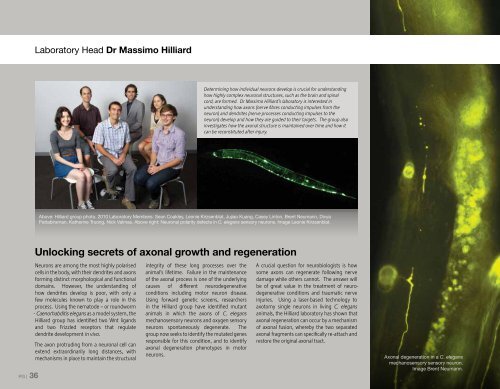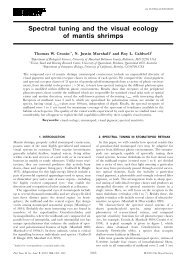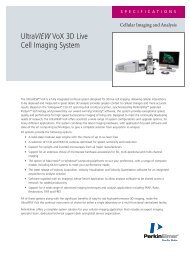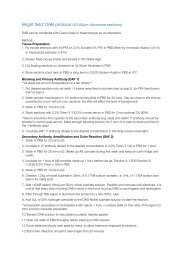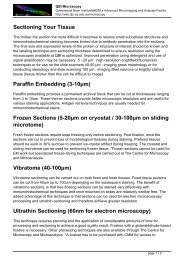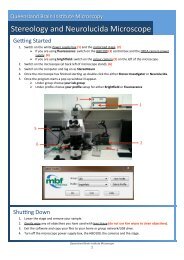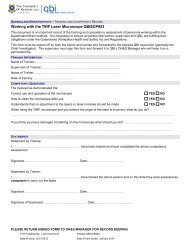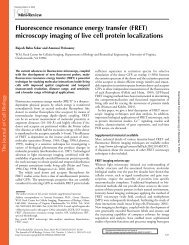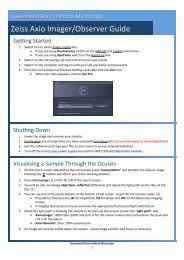Queensland Brain Institute 2010 Annual Report - University of ...
Queensland Brain Institute 2010 Annual Report - University of ...
Queensland Brain Institute 2010 Annual Report - University of ...
You also want an ePaper? Increase the reach of your titles
YUMPU automatically turns print PDFs into web optimized ePapers that Google loves.
Laboratory Head Dr Massimo HilliardDetermining how individual neurons develop is crucial for understandinghow highly complex neuronal structures, such as the brain and spinalcord, are formed. Dr Massimo Hilliard’s laboratory is interested inunderstanding how axons (nerve fibres conducting impulses from theneuron) and dendrites (nerve processes conducting impulses to theneuron) develop and how they are guided to their targets. The group alsoinvestigates how the axonal structure is maintained over time and how itcan be reconstituted after injury.Above: Hilliard group photo. <strong>2010</strong> Laboratory Members: Sean Coakley, Leonie Kirzsenblat, Jujiao Kuang, Casey Linton, Brent Neumann, DivyaPattabiraman, Katherine Truong, Nick Valmas. Above right: Neuronal polarity defects in C. elegans sensory neurons. Image Leonie Kirzsenblat.PG | 36Unlocking secrets <strong>of</strong> axonal growth and regenerationNeurons are among the most highly polarisedcells in the body, with their dendrites and axonsforming distinct morphological and functionaldomains. However, the understanding <strong>of</strong>how dendrites develop is poor, with only afew molecules known to play a role in thisprocess. Using the nematode – or roundworm- Caenorhabditis elegans as a model system, theHilliard group has identified two Wnt ligandsand two Frizzled receptors that regulatedendrite development in vivo.The axon protruding from a neuronal cell canextend extraordinarily long distances, withmechanisms in place to maintain the structuralintegrity <strong>of</strong> these long processes over theanimal’s lifetime. Failure in the maintenance<strong>of</strong> the axonal process is one <strong>of</strong> the underlyingcauses <strong>of</strong> different neurodegenerativeconditions including motor neuron disease.Using forward genetic screens, researchersin the Hilliard group have identified mutantanimals in which the axons <strong>of</strong> C. elegansmechanosensory neurons and oxygen sensoryneurons spontaneously degenerate. Thegroup now seeks to identify the mutated genesresponsible for this condition, and to identifyaxonal degeneration phenotypes in motorneurons.A crucial question for neurobiologists is howsome axons can regenerate following nervedamage while others cannot. The answer willbe <strong>of</strong> great value in the treatment <strong>of</strong> neurodegenerativeconditions and traumatic nerveinjuries. Using a laser-based technology toaxotomy single neurons in living C. elegansanimals, the Hilliard laboratory has shown thataxonal regeneration can occur by a mechanism<strong>of</strong> axonal fusion, whereby the two separatedaxonal fragments can specifically re-attach andrestore the original axonal tract.Axonal degeneration in a C. elegansmechanosensory sensory neuron.Image Brent Neumann.


